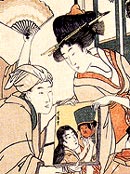

ISHIWATA Kôitsu (石渡江逸)
|
Ishiwata Kôitsu (石渡江逸 1897-1987), whose given name was Shôichirô, was a Nihonga (Japanese-style) painter who also worked in design and fabric dyeing, achieving a reputation in the 1920s as a fabric designer in Yokohama. He apparently developed an interest in printmaking through his study with Kawase Hasui. By the 1930s he had chosen his art name and concentrated on designing woodblock prints in the shin hanga style, issuing many with the publisher Watanabe Shôzaburô.
 |
| Ishiwata Koitsu: Namamugi no seki (Evening at Namamugi: 生麦の夕) Published by Watanabe Shôzaburô, 5/1931 |
Among these were views of small towns and street scenes, which often emphasized the every-day quality of contemporary life and the details of ordinariness, distinguishing some of his work from that of his mentor Hasui's often more romanticized and grander vision of the Japanese landscape and cityscape. Late in his career Kôitsu combined woodblock with stencil printing, sometimes published by Katô Junji.
The illustration on the right is signed Kôitsu above the artist's diamond-shaped seal. In the lower left margin the print is titled Namamugi no seki (Evening at Namamugi: : 生麦の夕), and dated Shôwa rokunen gogetsu saku ("Made in the fifth month of Shôwa 6"), corresponding to May 1931. The inscription in the lower right margin is the publisher's copyright, which reads Hanmoto Watanabe hanga ten ("Print Shop of the Publisher Watanabe").
Light from the setting sun casts shadows upon the canal below an orange-hued horizon while a crescent moon rises in a dark blue sky. The quiet scene is filled with precisely rendered details of small boats, watery reflections, wood structures, tilted poles, broken fences tied with rope, stone walls, loose bricks, and scattered small rocks. A near-perfect natural light illuminates an imperfect man-made scene, beautifully depicted in the medium of the woodblock print.
Prints by Ishiwata Kôitsu can be found in many private collections as well as public institutions such as the Carnegie Museum of Art, Pittsburgh; Fine Arts Museums of San Francisco; Harvard Art Museums, MA; Honolulu Museum of Art; Los Angeles County Museum of Art; Musées royaux d'art et d'histoire, Bruxelles; Museum of Fine Arts, Boston; and National Museum of Asian Art, Smithsonian, Washington DC;
Note: There was another artist working in the shin hanga style named Tsuchiya Kôitsu (土屋光逸 1870-1949), whose art name (Kôitsu 光逸) was pronounced the same but written differently. © 2001-2020 by John Fiorillo
BIBLIOGRAPHY
- Stephens, Amy Reigle (ed.): The New Wave: Twentieth Century Japanese Prints from the Robert O. Muller Collection. London & Leiden: Bamboo Publishing & Hotei Japanese Prints, 1993, p. 178, plates 224-225.
- Smith, Laurence: The Japanese Print Since 1900: Old Dreams and New Vision. British Museum, London, pp. 96-97, plates 75-76.
Viewing Japanese Prints |